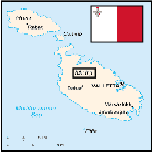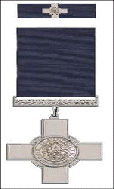

This page tells the story of the Mediterranean island country of Malta during the Second World War, through facts and illustrated by stories from the Victor and Hornet comics.
 |
 |
left - a map of Malta and right - the George Cross won by its people during World War Two.
The country of Malta consists of three islands, the main one Malta, Gozo and Comino. The Treaty of Paris in 1814 saw Malta become a part of the British Empire. The British used the islands as a shipping way-station and fleet headquarters. Malta was of strategic value to the British as it was situated between the Strait of Gibraltar and the Suez Canal in Egypt which allowed ships to travel onto the Far East. This route being regarded as an important trade route and the centrepiece of Britain’s strategic naval position in the Mediterranean Sea.
The Maltese people benefited from this route by the introduction of several new products examples of which include wheat (for bread making) and bacon. Relations between the British and the Maltese people were not always harmonious. A riot in 1919 over new taxes left four Maltese men dead. This day is commemorated every year in Malta. The country gained its independence from the United Kingdom on 21st September 1964 and became a republic on the 13th December 1974. Malta remains apart of the Commonwealth of Nations.
Captial - Valletta.
Population approximately 408,330 (as of July 2011).
The people of Malta speak their official national language of Maltese and as a second language, English. The islands today are internationally known as a tourist resort with several historical monuments and including nine UNESCO World Heritage sites. The islands are also a freight transshipment point and financial centre.
August 1942 - The oil tanker Ohio carrying much needed petrol for the RAF planes defending Malta, survives a torpedo attack and somehow the crippled ship, with two destroyers lashed on either side of the tanker, manages to limp into Valletta harbour, to receive a hero's welcome.
The GC was awarded to the island of Malta in a letter dated 15 April 1942 from King George VI to the island's Governor Lieutenant-General Sir William Dobbie:
The George Cross is woven into the Flag of Malta (top left hand corner) and can be seen wherever the flag is flown.
The GC is ranked after the Victoria Cross (VC) and is the highest gallantry award for civilians and military personnel for actions which are not in the face of the enemy. Usually awarded to individuals, this is the only occasion the medal has been awarded to a country.
Sources
www.wikipedia.org
http://www.bbc.co.uk/history/worldwars/wwtwo/siege_malta_01.shtml#two
The brief one page article below tells of the siege of Malta, from the Victor issue 431, artist not known.
 |
Another factual account below also tells the story of the siege of Malta. Artist Bevan from the Victor annual 1977.
 |
 |
 |
 |
The next factual story below tells of the oilship Ohio's adventures as she makes the perilous journey to the be-sieged island of Malta. Artist Sanchis, from the Victor 1973 annual.
 |
 |
 |
 |
 |
 |
 |
 |
There was other acts of heroism during the siege of Malta and one of those stories is told below. (Story from the Hornet issue 134, artist Ripol). And finally another RAF story about Canadian Sergeant-Pilot Beurling adventures. (Artist Coleman, from the Victor 768).
 |
 |
 |
 |
 |